
Are you looking to learn more about the Bird Of Paradise plant care? The Bird Of Paradise is popular among indoor houseplants, but it can be challenging to grow it. Keep reading to get advice on all the necessary details to grow a Strelitzia plant in the comfort of your home from light and temperature requirements to pruning, propagation and toxicity.
| Botanical Name (Latin Name/Scientific Name): | Strelitzia Reginae |
| Common Name: | Bird of Paradise |
| Light: | full sun (10,000 lux – 40,000+ lux) |
| Watering: | when the soil dries out to the bottom of the pot |
| Soil: | well-draining mix |
| Repotting: | once a year |
| Temperature: | 65°F to 80°F (18°C to 26°C) |
| Humidity: | around 60%, but adapts well to any humidity |
| Toxicity for Pets: | Yes (vomiting, nausea, drowsiness) |
| Toxicity for Humans: | Non-toxic |
| Propagation: |
|
| Pruning: | Prune dead or diseased growth or when you want the plant to branch out |
Light Requirements
| Minimal amount of light: | 10,000 lux (1,000 FC) |
| Optimal amount of light: | 40,000+ lux (4,000+ FC) |
| Direct sun tolerance: | 8 hours |
| Category: | full sun |
The light needs for Strelitzia are typically high, as the Bird Of Paradise plant needs a lot of sunlight to thrive. Like many tropical plants, Strelitzia is a full sun plant, so providing adequate lighting is essential for the proper Bird Of Paradise care.
Like most full sun plants, the Bird of Paradise prefers full sun (direct sun most of the day), which is why you should place it near a window with enough light for its needs.
When it comes to light exposure, its minimal light requirement is 10,000 lux (1000 FC), but it would grow much better with 40,000 lux (4000 FC) or more. The more bright light you provide, the faster your plant will thrive and grow taller, healthy, and strong. If you decide to grow your Bird Of Paradise outdoors, it will thrive in warm climates.
As the Bird Of Paradise loves the sun, you can allow it to soak in direct sun for 8 hours a day. If your home doesn’t have the best light conditions and there’s not enough light, you can always consider light supplementation to provide more bright light and help your plant to grow.
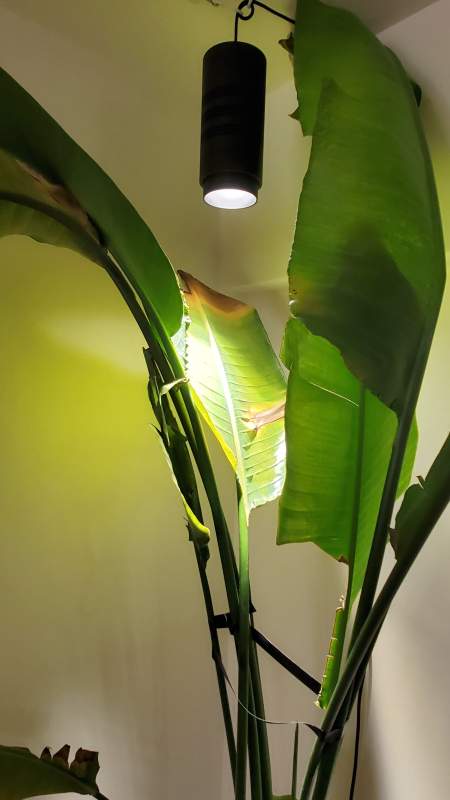
It’s essential to provide adequate light for your Bird Of Paradise plant to grow successfully.
Water Needs
To properly water a Strelitzia plant, you should let the soil dry out completely before watering it again, as it tolerates better staying dry than remaining moist. It’s not a thirsty plant, so it’s better to provide it with less water than to overwater it.
This is how much your plant can grow in about a year:
There’s no direct schedule you can follow, as the plant will need different watering frequencies depending on the environment in your home. However, it is helpful to observe the Strelitzia and see how long it takes to dry out inside your home. That will allow you to make a personalized watering schedule and stick to specific watering days.
For most houseplants, you should aim for the soil to dry out in about 7 days. If your plant’s soil remains wet for longer than 7 days, it could potentially develop root rot, which is why you should take this maintenance step seriously.
What Are The Indications Of Overwatering Of Strelitzia?
The indicators of overwatering of Strelitzia are leaf browning, and the petioles will slowly turn brown and a bit soft due to excess water. As a result of overwatering, roots start to rot and this leads to stems becoming soft and mushy over time.
What Are The Symptoms Of Underwatered Strelitzia?
The symptoms of an underwatered Bird Of Paradise are similar to those of an overwatered Strelitzia plant. When you underwater your Bird Of Paradise, it will get brown leaves and drooping leaves.
Humidity Needs
When it comes to humidity needs, the Bird of Paradise is a tropical plant, meaning it’s used to high humidity in its natural habitat. However, like most houseplants, it can adapt to low humidity quite easily. It will enjoy spaces with around 60% humidity, but it will grow without issues in much less humid areas.
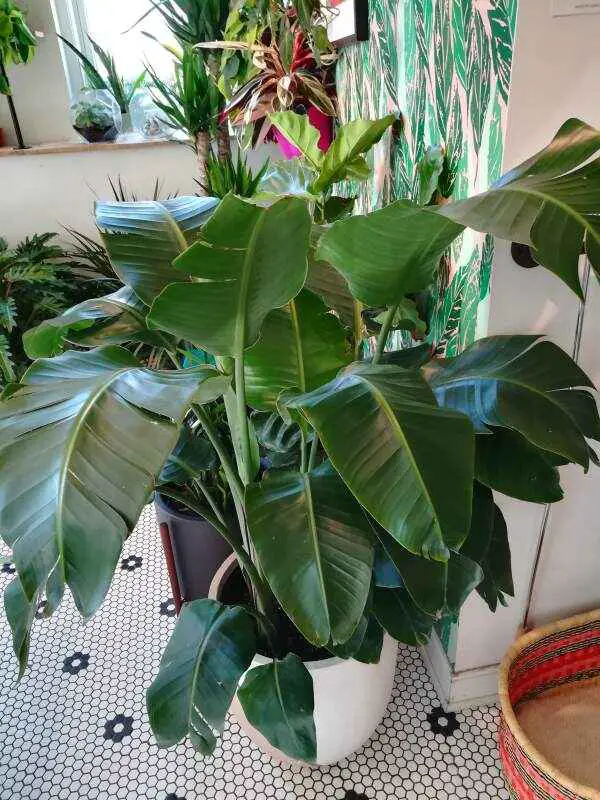
Strelitzia, the plant we also know as the Bird Of Paradise, is an easy-going plant you can grow inside your home
Temperature Requirements
The Bird Of Paradise plants flourish in temperatures between 65°F (18°C) and 80°F (26°C). However, Strelitzia can withstand temperatures as low as 24°F (-4°C) for a short period.
Fertilizing
Like most houseplants, Strelitzia doesn’t need fertilization if you repot it annually. The fresh soil will provide new nutrients required for proper development. However, if you want to fertilize the plant and enhance your Bird Of Paradise care, you can do it. Make sure to follow instructions on the fertilizer packaging, as it’s possible to overfertilize a plant.
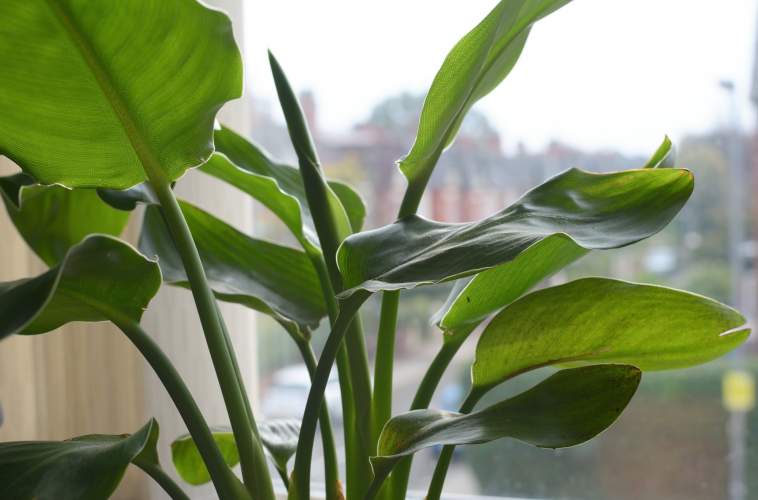
The Bird Of Paradise is a stunning indoor plant that doesn’t require fertilization if you repot it annually.
If you decide you want to fertilize your Strelitzia plant, you can try out the Sill fertilizer, as it has an excellent N-P-K ratio of 9-3-6.
Soil
The best potting soil for the Bird Of Paradise should contain:
If you don’t currently have these amendments, you can replace them with similar ones, such as pumice, coarse sand, or vermiculite. That way, you will create a well-draining soil mixture that will help your plant’s roots get the needed oxygen for growth.
It’s crucial provide your Strelitzia with the best Bird Of Paradise plant care, you need to consider the soil in which the plant will grow. That’s why instead of using a potting mix right out of the bag, I suggest amending it to prevent water retention, as it’s essential to take care of the soil moisture.
Store-bought potting mixes commonly retain a lot of water, leading to root rot in your Bird Of Paradise. Also, due to the particles in regular potting mixes being very small, your plant might not get enough oxygen for proper root development.
Repotting
When repotting, consider using a 2” larger pot than the plant’s current one, preferably with drainage holes. Carefully remove the Bird of Paradise plant from its current pot. If it’s difficult to remove the plant from the container, you can use a repotting rake to pull the soil away from the pot edges. Next, loosen the root ball with repotting rake or your fingers. Use a well-draining mix to fill 1/3 of a new container before you place the plant. Put the plant in the flower pot and add the rest of the soil until the pot is full. Press the soil firmly with your fingers and water it.
Toxicity To Humans
Bird Of Paradise is not toxic to humans, according to Ann King Filmer, Ph.D. Plant Scientist from the University of California, in the publication “Safe and Poisonous Garden Plants” from October 2012. However, remember that non-toxic plants can sometimes cause vomiting in humans. So keep the plant away from the children.
Toxicity To Pets
The bird Of Paradise plant is toxic to cats, dogs, and horses due to the gastrointestinal irritants inside the plant’s fruits and seeds according to the American Society For The Prevention Of Cruelty To Animals (ASPCA). If you have pets, you should keep them away from the Bird Of Paradise, as they could develop an array of issues such as vomiting, nausea, drowsiness.
Pruning
There’s no need to prune your Bird Of Paradise plants if they’re healthy. However, if the leaves have brown edges or brown patches, feel free to cut them off. Dry brown leaf tissue is dead, it will not harm your plant to cut it off and will improve the look of the plant. You should prune your Bird Of Paradise if you notice that the plant is sick, diseased, or has dying parts.
Propagation
To propagate Bird Of Paradise plants through division, you can follow these steps:
- Dig the soil and separate the plant using pruning shears or a spade
- When replanting the divisions, you should place them in the same-depth soil as they were planted previously
- Allow the new plants to establish roots in a dry environment
- You can propagate your Bird Of Paradise any time of year
Note that you cannot propagate Strelitzia through leaves, as they do not contain the cells needed to produce new roots or shoots.
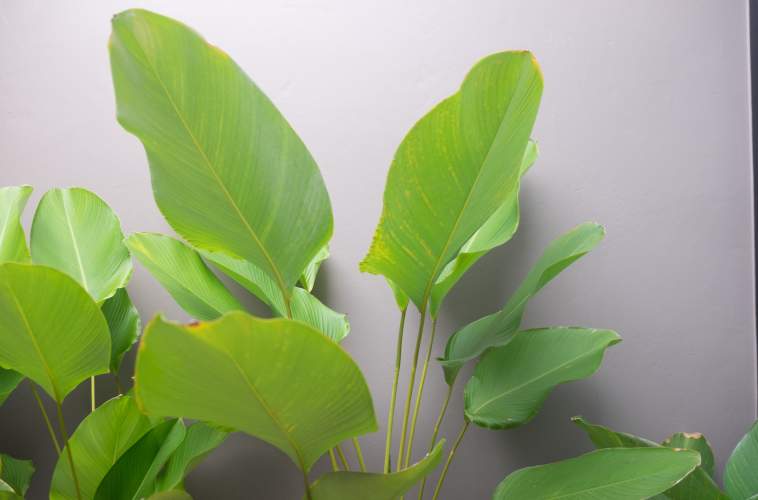
As you cannot propagate the Bird Of Paradise using individual leaves, you’ll need to turn to the division propagating technique
FAQs about Bird Of Paradise
Are Strelitzia Plants Easy to Care for?
Yes, Strelitzia plants are easy to care for. Be sure to provide them with sufficient light and to not overwater them. They are low-maintenance plants that are drought-tolerant and can survive in poor soil conditions. Strelitzia plants should be protected from wind as the leaves can split otherwise.
How to Tell if My Strelitzia Is Getting Enough Light?
You can tell that your Strelitzia plant is getting enough light if it’s actively growing. Also if the leaves look healthy without pests and diseases and if the leaf stems don’t look long and leggy then your plant is most likely getting enough light.
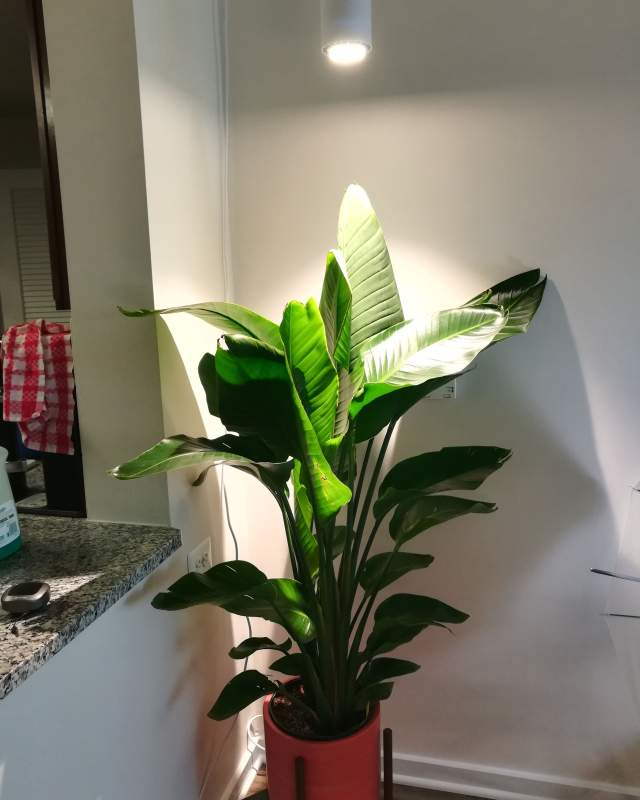
Strelitzia getting enough light
How Fast Does Strelitzia Grow?
Strelitzia is not a very fast grower. It can grow a few leaves annually.
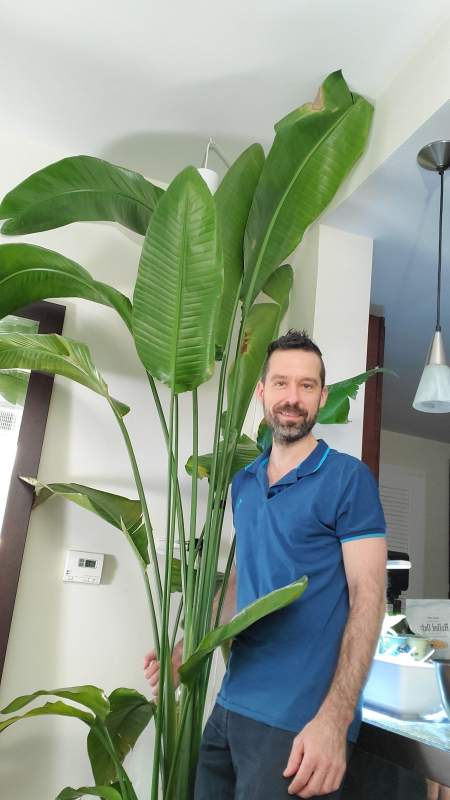
Mr. Houseplant with his Strelitzia
Why Are the Leaves of My Strelitzia Turning Brown?
Strelitzia leaves can turn brown for one of the several reasons:
- improper watering (overwatering, underwatering)
- pests
- diseases
- sunburns
- grow light burns
- soil compaction
Can Bird of Paradise Flower Indoors?
Bird of Paradise can flower indoors if it’s getting enough light. Flowering plants generally require much more light than their non-flowering counterparts so your Bird of Paradise needs lots of direct sun if you want it to flower. The plant should also be in well-draining soil. If you can provide these conditions, your Bird of Paradise plant should bloom indoors.
Yours Truly,



Related Posts
Sansevieria Black Gold (Snake Plant Care GUIDE!)
Spathiphyllum Sensation (FULLY Explained!)
Alocasia Stingray Care